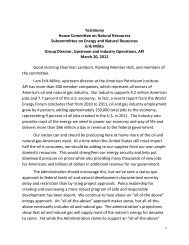Mr. Stephen Mealey - The House Committee on Natural Resources ...
Mr. Stephen Mealey - The House Committee on Natural Resources ...
Mr. Stephen Mealey - The House Committee on Natural Resources ...
Create successful ePaper yourself
Turn your PDF publications into a flip-book with our unique Google optimized e-Paper software.
Bush in 2001 in their Wildlife for the 21 st Century, Volume I, Recommendati<strong>on</strong> to President George W.<br />
Bush that he initiate an assessment of federal land laws to identify legal and regulatory problems<br />
c<strong>on</strong>tributing to federal land management “gridlock”.<br />
C<strong>on</strong>text: Rachel Cars<strong>on</strong>’s Silent Spring<br />
<str<strong>on</strong>g>The</str<strong>on</strong>g>re is important c<strong>on</strong>text for the “federal land/regulatory law” problem. <str<strong>on</strong>g>The</str<strong>on</strong>g> American Ecology Hall of<br />
Fame states: “In 1992, a panel of distinguished Americans declared Rachel Cars<strong>on</strong>’s 1962 Silent Spring<br />
the most influential book of the past 50 years. Many argue that Silent Spring was instrumental in<br />
launching the American envir<strong>on</strong>mental movement. Passage of NEPA in 1969 and establishment of the<br />
CEQ and EPA in 1970 can be attributed to the envir<strong>on</strong>mental awareness that Cars<strong>on</strong> raised. So<strong>on</strong> after<br />
NEPA, the Clean Air Act (CAA) of 1970, the CWA of 1972, and the ESA of 1973 were all passed, all<br />
traceable to the spirit of envir<strong>on</strong>mental awareness and c<strong>on</strong>cern raised by Rachel Cars<strong>on</strong>.<br />
Comm<strong>on</strong> to Silent Spring and the federal regulatory laws that followed, was c<strong>on</strong>cern for documenting<br />
and reducing envir<strong>on</strong>mental harm man was causing through development acti<strong>on</strong>s. Envir<strong>on</strong>mental<br />
regulati<strong>on</strong> focused <strong>on</strong> proposals for major acti<strong>on</strong>s (acts of commissi<strong>on</strong>), their envir<strong>on</strong>mental impacts,<br />
their adverse effects, and standards or alternatives to prevent or mitigate adverse effects. Most regulatory<br />
attenti<strong>on</strong>, especially related to fire-pr<strong>on</strong>e forests of the West, has been <strong>on</strong> preventing short-term adverse<br />
effects of fuels treatment proposals with little attenti<strong>on</strong> to the short or l<strong>on</strong>g-term c<strong>on</strong>sequences of<br />
inacti<strong>on</strong> (acts of omissi<strong>on</strong>). <str<strong>on</strong>g>The</str<strong>on</strong>g> applicable theory in regulatory law, regulati<strong>on</strong>s and their<br />
implementati<strong>on</strong> appears to be that significant envir<strong>on</strong>mental risks result from committed acts<br />
rather than from their omissi<strong>on</strong>. Analyses supporting the theory c<strong>on</strong>tinue to be lacking.<br />
Jack Ward Thomas, while addressing a c<strong>on</strong>ference in October, 2002 in Bend, Oreg<strong>on</strong> entitled “Fire in<br />
Oreg<strong>on</strong>’s Forests” commented <strong>on</strong> the problem of “dynamic vs. static management” in fire influenced<br />
landscapes covered by the NWFP. Thomas noted that the combined effect of the envir<strong>on</strong>mental laws of<br />
the 1970s, especially the ESA, was the predominant use of preservati<strong>on</strong>ist strategies defined as static or<br />
“hands off” management to protect listed species (and water quality). He observed that reliance <strong>on</strong> static<br />
management minimizing immediate risks of activities has been routinely reinforced by federal court<br />
decisi<strong>on</strong>s that favor preservati<strong>on</strong>. Thomas c<strong>on</strong>cluded that serious problems with static, near-term risk<br />
averse management are emerging because ecosystems are dynamic and change is c<strong>on</strong>stant in preserves.<br />
In fire-pr<strong>on</strong>e forests, unabated fuel accumulati<strong>on</strong> leads to uncharacteristic wildfires that can ultimately<br />
harm listed species and water quality. Thomas saw these l<strong>on</strong>g-term effects of management inacti<strong>on</strong> as<br />
either ignored or downplayed.<br />
In the 50 years between Silent Spring and “static vs. dynamic management” how could laws intended to<br />
protect the envir<strong>on</strong>ment, actually put envir<strong>on</strong>mental assets at risk in fire pr<strong>on</strong>e forests of the West? A<br />
look at the precauti<strong>on</strong>ary nature of the ESA, and by inference the CWA and CAA, is instructive.<br />
<str<strong>on</strong>g>The</str<strong>on</strong>g> ESA takes a str<strong>on</strong>g but narrowly defined precauti<strong>on</strong>ary approach in the face of uncertainty about<br />
risk to species. It focuses <strong>on</strong> and seeks to prevent “take” by prohibiting mainly near-term potential<br />
and/or uncertain harm or risks. In c<strong>on</strong>sultati<strong>on</strong>s, prop<strong>on</strong>ents must dem<strong>on</strong>strate proposals would not be<br />
harmful regardless of timeframe, apparently dismissing ecological change over time. <str<strong>on</strong>g>The</str<strong>on</strong>g> ESA and its<br />
applicati<strong>on</strong> do not comm<strong>on</strong>ly distinguish the time dimensi<strong>on</strong> of risk: i.e., that some short-term risks to<br />
species can result in l<strong>on</strong>ger term benefits to those same species, or that short-term risk avoidance can<br />
7
















